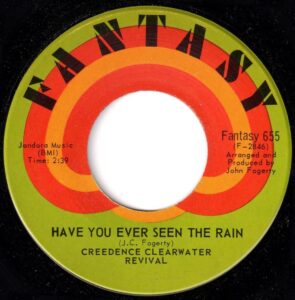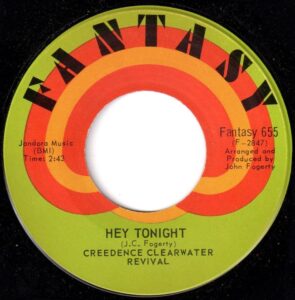#117: Have You Ever Seen The Rain/Hey Tonight by Creedence Clearwater Revival
Peak Month: February-March 1971
10 weeks on Vancouver’s CKVN chart
Peak Position #1
Peak Position on Billboard Hot 100 ~ #8
YouTube.com: “Have You Ever Seen The Rain”
Lyrics: “Have You Ever Seen The Rain”
John Fogerty was born in 1945 in Berkeley, California. He was raised in nearby El Cerrito. He learned to play guitar in his youth. In 1959 John Fogerty, Stu Cook and Doug Clifford formed a trio named the Blue Velvets. Based in El Cerrito, California, just north of Berkeley, they were joined in 1960 by John’s brother, Tom, who had been in a band called The Playboys. The Blue Velvets were influenced by Little Richard and other rock ‘n roll greats. They played a number of hits on the radio and their cover of Bobby Freeman’s “Do You Want To Dance,” was an audience favorite. In 1964 the Blue Velvets changed their name to the Golliwogs. They had a Top Ten hit called “Brown Eyed Girl” in San Jose (#7), Fresno (#3) and Miami (#8) in the winter of 1965-66. It was a blues infused tune, but not the same-titled song that Van Morrison would take up the charts the following year.
In 1966 John Fogerty was drafted into the U.S. Army reserves and was stationed in Fort Bragg, NC, and then in Fort Knox, KY, and finally Fort Lee, VA. Meanwhile, Doug Clifford went into the United States Coast Guard Reserve. Fogerty and Clifford finished their respective service in ‘Reserves in 1967. And in 1967 the Golliwogs changed their name to Creedence Clearwater Revival. This was because Saul Zaentz bought Fantasy Records and offered the Golliwogs a chance to record a studio album provided that they change their name.
The band chose the name to Creedence Clearwater Revival based on several different influences. Creedence was named after a friend of Tom Fogerty’s named Credence Nuball. The first name, with its connotations of faith and trust, appealed to the group. They all knew what it meant to give credence to something that you accept or trust is true. Clearwater also had several meanings. It came initially from a beer commercial. However, clearwater also connected with the emerging environmental movement and its back-to-the-land sentiment, a sentiment that was expressed in the Woodstock Festival and Joni Mitchell’s urgent message: “we’ve got to get ourselves back to the garden.” The word, revival, reflected the band’s intention to switch up their performance and recordings to a new level.
Doug Clifford was born in Palo Alto, California, and learned to play drums in his teens. Thomas Richard Fogerty was born in 1941 in Berkeley, California. In his teens he had a band called Spider Web that included future Seeds guitarist Jimmy Levine. Guitarist, Stu Cook, was also raised in the Bay Area. Their self-titled debut album was released in the summer of 1968. It included a cover of the Dale Hawkins classic from 1957, “Susie Q”.
It may be that CCR were thumbing through the “H” section of rock n’ roll singers when they decided to cover another song by a singer with the surname of Hawkins. Another track of their debut album was “I Put A Spell On You” by Screaming Jay Hawkins.
It was the second album, Bayou Country, that put Creedence Clearwater Revival on a path of almost constant success. They hit #2 in February 1969 in Vancouver (BC) and in March on the Billboard Hot 100 with “Proud Mary”. Their next single release was from their third studio album, Green River, titled “Bad Moon Rising”. The B-side was a song called “Lodi”. Just after “Bad Moon Rising”/”Lodi” had spent 5 weeks in the Top Ten of the CKLG Boss 30 in May-June, the band appeared in concert in Vancouver (BC) on July 11, 1969, at the Agrodome.
The next single CCR released was in July 1969 was the title track from their third studio album: “Green River”. The B-side was “Commotion”. CCR released one more single in 1969, “Down On The Corner”, with the B-side “Fortunate Son”.
CCR charted one single after another into the Top Ten. Many of their singles were double-sided hits. Of the 19 songs that charted on the Vancouver pop charts between September 1968 and May 1972, CCR charted 18 into the Top Ten and 17 of these into the top three positions. Nine of the songs made it to #1. In early 1970 CCR had a #2 hit with “Travelin’ Band”/”Who’ll Stop The Rain”. This was followed in the spring of 1970 with “Up Around The Bend”/”Run Through The Jungle”. The latter included comments about the proliferation of guns in America, “200 million guns are loading. Satan cries ‘take aim.'” The double-sided hit climbed to #1. As the single was climbing the pop charts in Vancouver, CCR appeared in concert at the Pacific Coliseum on May 1, 1970. And in September 1970 CCR had another double-sided #1 hit with “Looking Out My Back Door”/”Long As I Can See The Light”.
The band had a final #1 hit in Vancouver in March 1971 with “Have You Ever Seen The Rain”/”Hey Tonight”.

“Have You Ever Seen The Rain” was written by John Fogerty. In the song, Fogerty writes about rain “coming down on a sunny day.” Sun showers becomes a metaphor for some listeners. In his review for Allmusic website, Mark Deming suggests that the song is about the idealism of the 1960s and about how it faded in the wake of events such as the Altamont Free Concert and the Kent State shootings, and that Fogerty is saying that the same issues of the 1960s still existed in the 1970s but that people were no longer fighting for them. Some listeners wrote on Songfacts that they thought the “rain” was a metaphor for bombs falling on sunny days in Vietnam. Later, Fogerty in an interview stated the inspiration for the song came initially from the zenith of Creedence Clearwater Revival’s success. The band had what looked like a great horizon with more success ahead of it. Yet, there were interpersonal divisions that were making it rain on their success. The band began to break up in the winter of 1971-72.
“Have You Ever Seen The Rain” peaked at #1 in Vancouver *BC), Orlando, Chilliwack (BC), Kalamazoo (MI), Portland (OR), Salem (OR), and Scranton (PA), #2 in Los Angeles, Vancouver (WA), Cleveland, Bangor (ME), Fresno (CA), Eugene (OR), Calgary (AB), Hilo (HI), and Wilkes-Barre (PA), #3 in San Francisco, Tulsa (OK), Hamilton (ON), Salinas (CA), Ann Arbor (MI), Columbus (OH), Montreal, Bakersfield (CA), Birmingham (AL), and Reading (PA), #4 in Santa Rosa (CA), Lethbridge (AB), Barrie (ON), Albany (NY), New Haven (CT), San Bernardino (CA), Louisville (KY), and Chicago, #5 in Hartford (CT), Terre Haute (IN), Salt Lake City, Fort Worth (TX), Sioux Falls (SD), Des Moines (IA), Holland (MI), and Battle Creek (MI), Rochester (NY), #6 in San Diego, Pensacola (FL), Appleton (WI), St. John’s (NFLD), San Antonio (TX), Olympia (WA), Yakima (WA), Lexington (KY), Cedar Rapids (IA), Regina (SK), Mobile (AL), and Norfolk (VA), #7 Syracuse (NY), Detroit, and Canton (OH), St. Louis, and Windsor (ON), #8 in Sarasota (FL), Honolulu, Saskatoon (SK), Omaha (NE), and Youngstown (OH), #9 in Newport News (VA), Memphis, Worcester (MA), and Dallas (TX), and #10 in Philadelphia, Wichita (KS), and Indianapolis.
In about half of these radio markets, “Hey Tonight” was a double-sided hit single, climbing the chart in the same position with “Have You Ever Seen The Rain”.

“Hey Tonight” was also written by John Fogerty. It’s a song about people partying “Don’t you know I’m buying” (another round). As well, “Jody’s gonna get religion” is a reference to having sex and what someone might moan during the encounter “(Oh God, Oh God…).” The chart run for “Have You Ever Seen The Rain”/”Hey Tonight” didn’t make it onto the list for the Billboard Top 100 Singles of 1971.
A final appearance in the Top Ten for Creedence Clearwater Revival was in August 1971 with “Sweet Hitch Hiker”.
Dissension between bandmates led to the demise of Creedence Clearwater Revival. Tom was not getting along with his brother, John. Tom left the band in 1971. Stu and Doug quit after January 1972, after the band recorded the album, Mardi Gras, that critics panned. Their hit from the summer of 1971, “Sweet Hitch Hiker”, was on the album. A minor Top 30 hit in late spring 1972, “Someday Never Comes”, was also a track on the album.
Tom Fogerty moved to Arizona and from a blood transfusion contracted HIV in 1986 and died in 1990. Doug Clifford played drums on 14 albums between 1972 and 2008, including for Tom Fogerty, Sir Douglas Quintet and Steve Miller Band. Stu Cook, along with Doug Clifford, joined a roots band named the Don Harrison Band. In 1995 Cook and Clifford formed Creedence Clearwater Revisited, along with three other musicians.
John Fogerty wrote many of CCR’s songs, including “Proud Mary”, “Bad Moon Rising” and “Green River”. After Creedence Clearwater Revival split up in 1972 John Fogerty pursued a solo career. His cover of “Jambalaya (On The Bayou)” climbed into the Top 20 across the USA and in Vancouver in 1972. Fogerty had a Top Ten single in 1984 titled “The Old Man Down The Road.”
October 17, 2022
Ray McGinnis
References:
“Creedence Clearwater Revival Bio,” Creedence Online.net.
John Fogerty, Fortunate Son: My Life, My Music, (Little Brown and Company, 2015).
John Fogerty tour dates.
Hank Bordowitz, Bad Moon Rising: The Unauthorized History of Creedence Clearwater Revival, (Chicago Review Press, 2007).
Thomas M Kitts, Finding Fogerty: Interdisciplinary Readings of John Fogerty and Creedence Clearwater Revival, (Lexington Books, 2012).
Dorian Lynsky, ” John Fogerty: ‘I had rules. I wasn’t embarrassed that I was ambitious’,” Guardian, May 29, 2013.
Bob Baker, “Their Son was Fogerty’s Baby,” Los Angeles Times, October 23, 2002.
For more song reviews visit the Countdown.

Leave a Reply